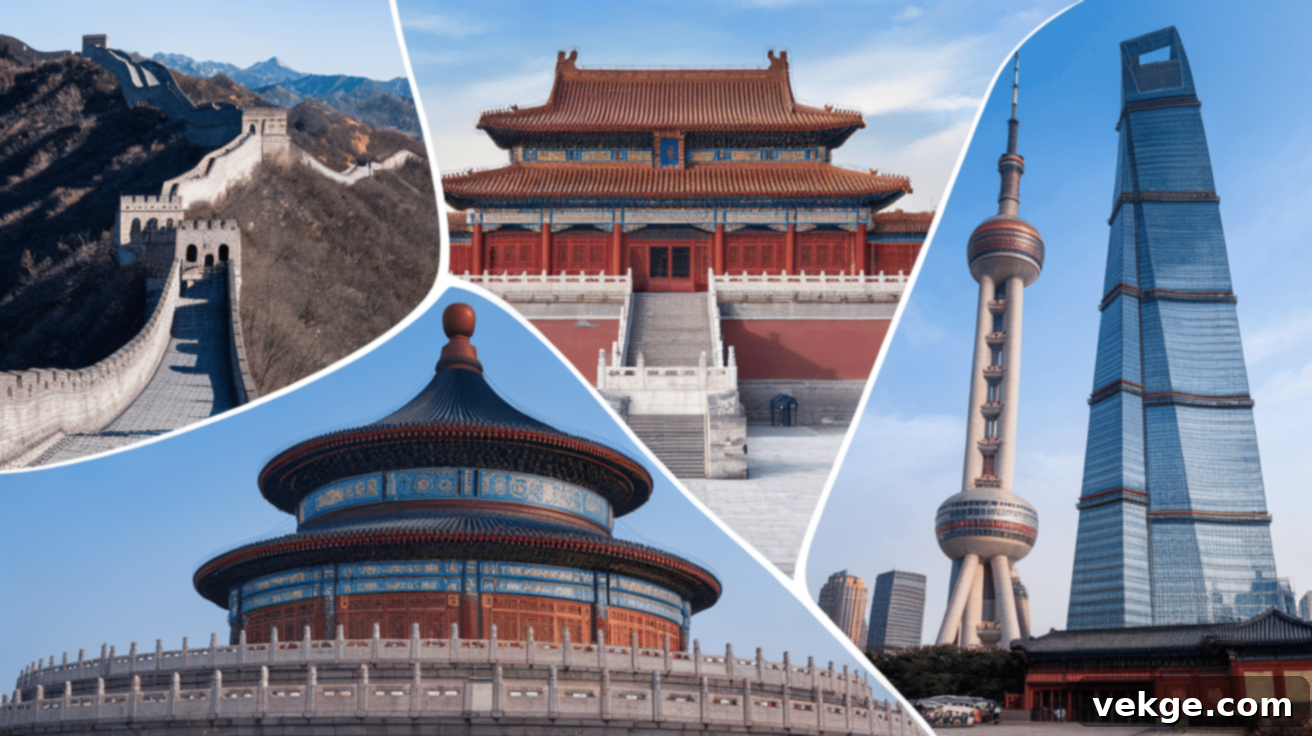Explore China’s Iconic Architecture: Ancient Wonders to Modern Marvels
China is a land of unparalleled architectural diversity, boasting some of the world’s most breathtaking structures. From ancient imperial palaces and serene temples that whisper tales of bygone dynasties to dazzling modern skyscrapers that touch the clouds, Chinese architecture brilliantly showcases the nation’s profound history and its ambitious, innovative future. This journey through China’s most famous buildings offers a unique glimpse into its rich cultural tapestry, technological prowess, and evolving artistic expressions.
This comprehensive guide delves into the fascinating stories behind China’s architectural masterpieces. You will embark on a historical voyage, learning about revered ancient sites such as the majestic Forbidden City, the spiritual Shaolin Temple, and the serene Temple of Heaven. Simultaneously, we will marvel at contemporary wonders like the iconic Bird’s Nest Stadium and the soaring Shanghai Tower, symbols of China’s modern ascent.
Each building featured in this article possesses its own distinct narrative, unique design philosophy, and profound cultural significance. Some structures have stood resilient for over a millennium, bearing witness to countless historical events, while others are recent additions, pushing the boundaries of engineering and design. Together, they form a compelling testament to how China’s architectural landscape has evolved through the ages, consistently maintaining its unique character and deep connection to its heritage.
Why These Architectural Landmarks Hold Immense Significance
These distinguished Chinese landmarks are far more than mere constructions; they are tangible manifestations of China’s enduring history, rich culture, and dynamic spirit. They serve as crucial links connecting the past, present, and future, offering invaluable insights into the nation’s identity.
Ancient edifices, such as the sprawling Forbidden City and venerable Buddhist and Taoist temples, provide an invaluable window into how people lived, governed, and worshipped centuries ago. They are living museums that help us decipher ancient Chinese philosophies, understand traditional beliefs, and appreciate the intricate customs that shaped one of the world’s oldest civilizations. These structures embody the meticulous craftsmanship, sophisticated engineering, and profound aesthetic principles developed over millennia, often harmonizing with natural landscapes.
Conversely, modern architectural marvels, exemplified by the “Bird’s Nest” stadium and the distinctive CCTV Headquarters, boldly declare China’s emergence as a global economic and technological powerhouse. These buildings are at the forefront of contemporary design, pushing the limits of innovation and showcasing cutting-edge construction techniques. They represent new ideas, global collaborations, and a forward-looking vision for the future, symbolizing China’s confidence and ambition on the world stage.
Beyond their cultural and historical value, these landmarks are pivotal economic drivers, attracting millions of international and domestic visitors annually. This vibrant tourism sector generates substantial revenue, creates numerous jobs, and stimulates local economies. Furthermore, many of these sites have been designated UNESCO World Heritage sites, an international recognition that underscores their universal value and ensures their protection and preservation for future generations. By safeguarding these extraordinary places, we ensure that people from across the globe can continue to learn about China’s illustrious past while observing its continuous transformation and development. They stand as powerful physical connections, bridging China’s glorious history with its vibrant, ever-evolving future.
A Curated List of China’s Most Famous Buildings and Architectural Gems
China’s landscape is dotted with an astonishing array of buildings, each narrating a different chapter of its history and culture. From the sacred grounds of ancient monasteries to the grand stages of Olympic venues, these structures capture the imagination and inspire awe. Here, we present a meticulously curated list of some of the most remarkable architectural wonders China has to offer.
1. Labrang Tashi Kyil Monastery
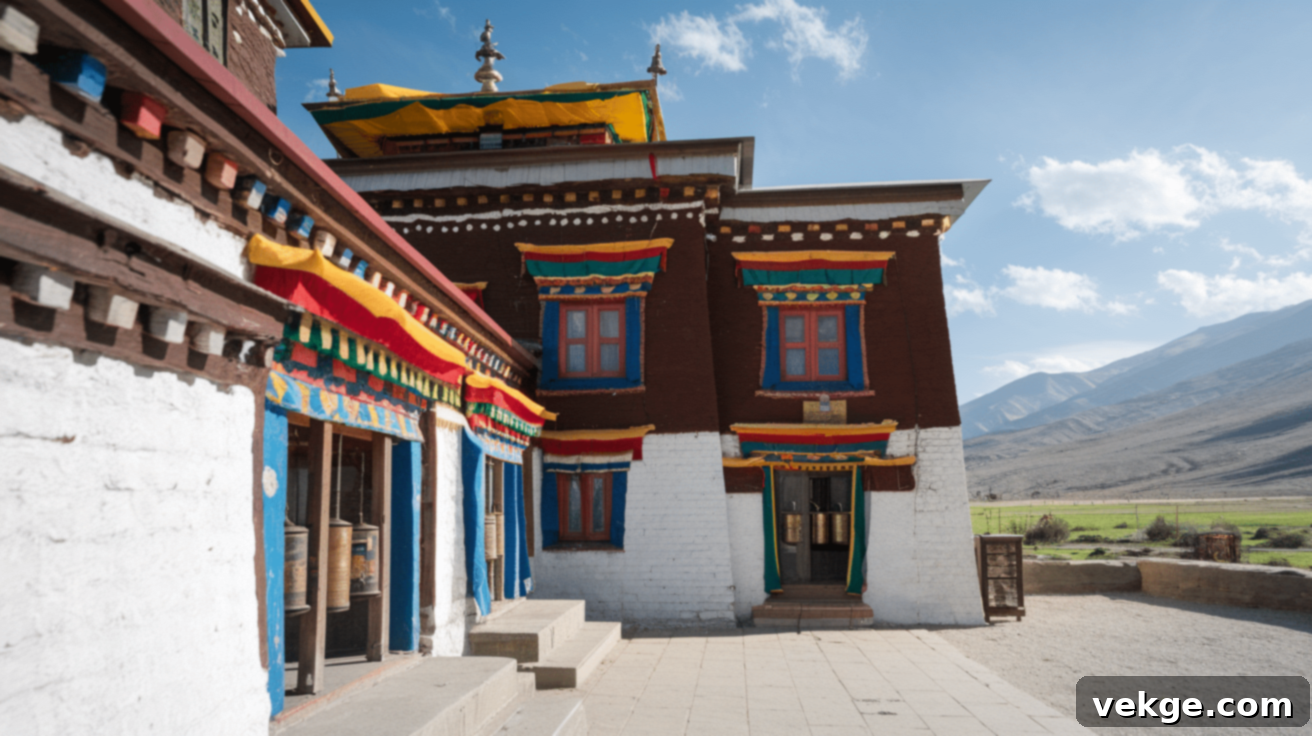
Nestled in the picturesque mountains of Gansu province, the Labrang Tashi Kyil Monastery stands as one of the most significant Tibetan Buddhist monasteries outside of Lhasa. Founded in 1709, this sprawling complex is an integral center for Gelugpa (Yellow Hat) Buddhism, housing numerous prayer halls, colleges, and residences for thousands of monks. Its architecture reflects traditional Tibetan styles, with vibrant colors, intricate murals, and golden rooftops that gleam under the sun.
The monastery is renowned for its vast collection of Buddhist scriptures, thangka paintings, and exquisite statues, including the revered golden Buddha. Visitors are often captivated by the serene atmosphere, the rhythmic chanting of monks, and the sight of pilgrims circumambulating the monastery with prayer wheels. The blend of spiritual importance and breathtaking natural scenery makes Labrang Tashi Kyil a truly unforgettable destination, offering a deep immersion into Tibetan culture and religious practices.
2. Shaolin Temple
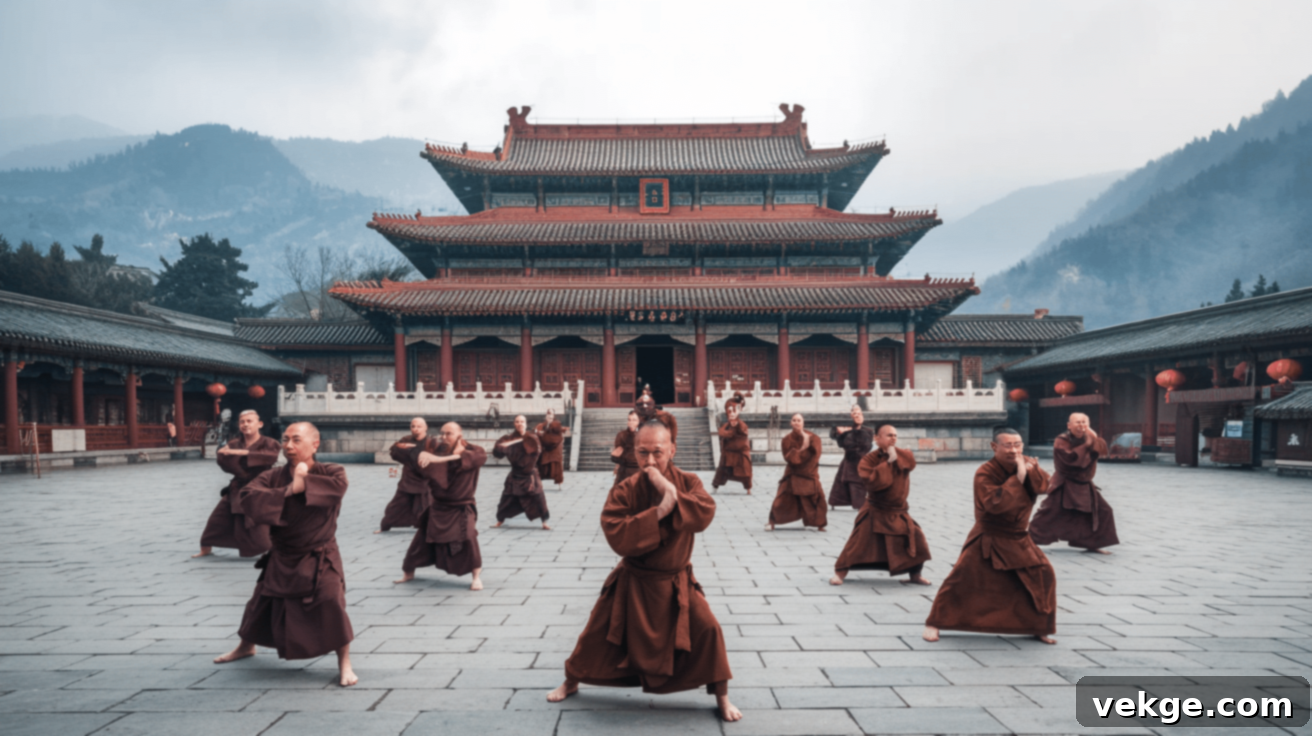
Located in the heart of Dengfeng, Henan province, the Shaolin Temple is globally celebrated as the birthplace of Zen Buddhism and the spiritual home of Shaolin kung fu. Established in 495 AD, its ancient halls and courtyards resonate with centuries of spiritual discipline and martial arts tradition. Key structures include the Mahavira Hall and the iconic Thousand Buddhas Hall, adorned with stunning murals depicting scenes from Buddhist history and legendary kung fu masters.
Beyond its architectural beauty, the temple’s profound historical significance is undeniable. It is here that Bodhidharma is said to have introduced Chan Buddhism (Zen) to China. Adjacent to the temple lies the Pagoda Forest, a unique graveyard housing over 240 tomb pagodas built since 791 AD for eminent monks and abbots, each varying in size and style, reflecting different dynasties. Visiting Shaolin Temple offers a captivating blend of spiritual tranquility, martial arts demonstrations, and a deep dive into an essential chapter of Chinese cultural history.
3. Kowloon Ventilation Building
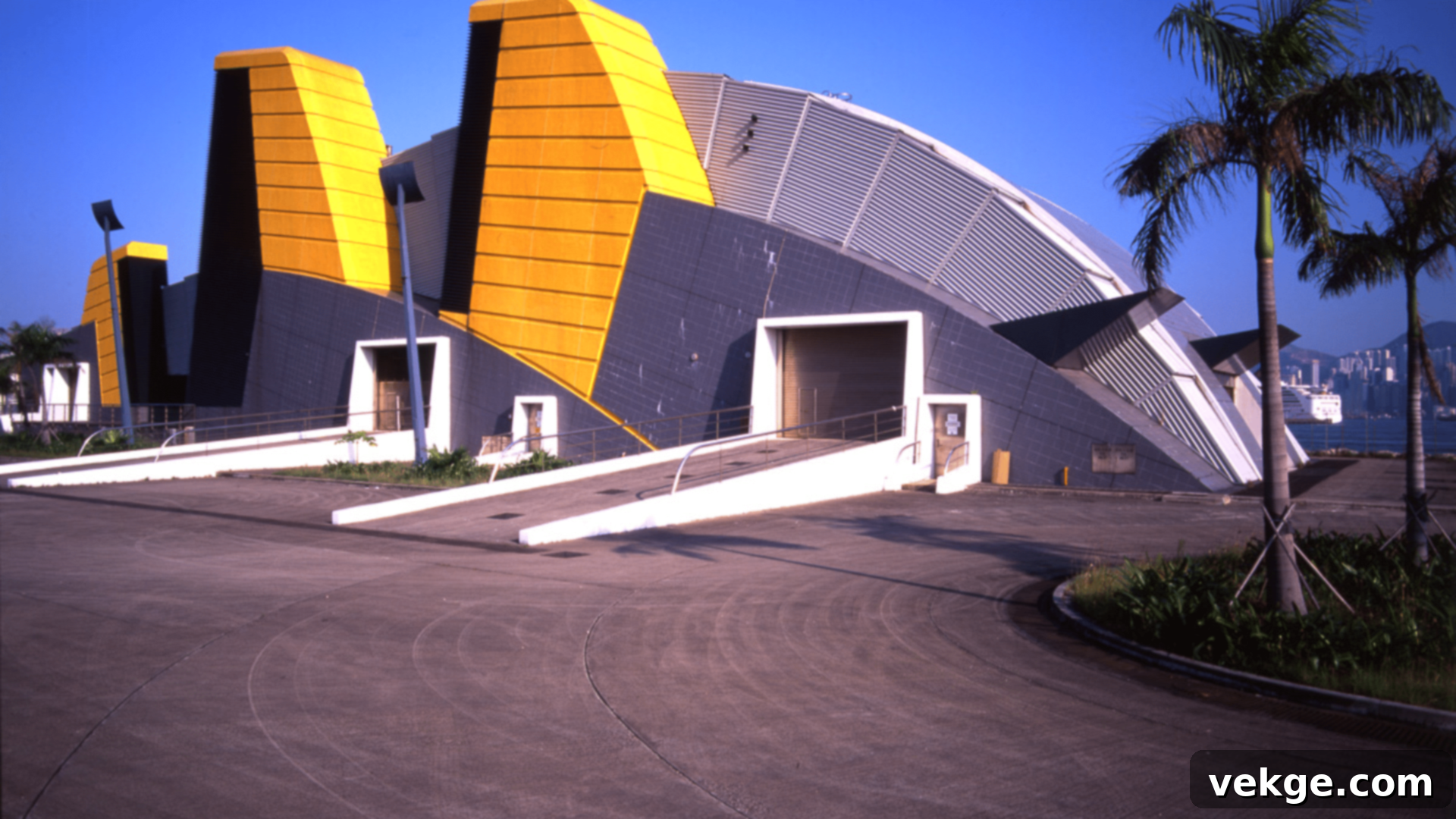
In Hong Kong, amidst its bustling urban landscape, stands the distinctive Kowloon Ventilation Building. This functional structure, a crucial component of the city’s airport railway system, is ingeniously designed to ventilate the extensive underground tunnels. What sets it apart is its unique architectural form, which appears like a graceful, crouched animal, harmoniously blending with the surrounding natural environment.
Inspired by the gentle undulations of the harbor waves, the building’s fluid lines and organic shape defy conventional industrial design. It serves as a testament to how essential urban infrastructure can also be a work of art, enhancing the cityscape rather than detracting from it. The Kowloon Ventilation Building is a remarkable example of modern architecture that prioritizes both utility and aesthetic integration, solidifying its status as a notable contemporary landmark in Hong Kong.
4. Hanging Monastery of Xuan Kong Si
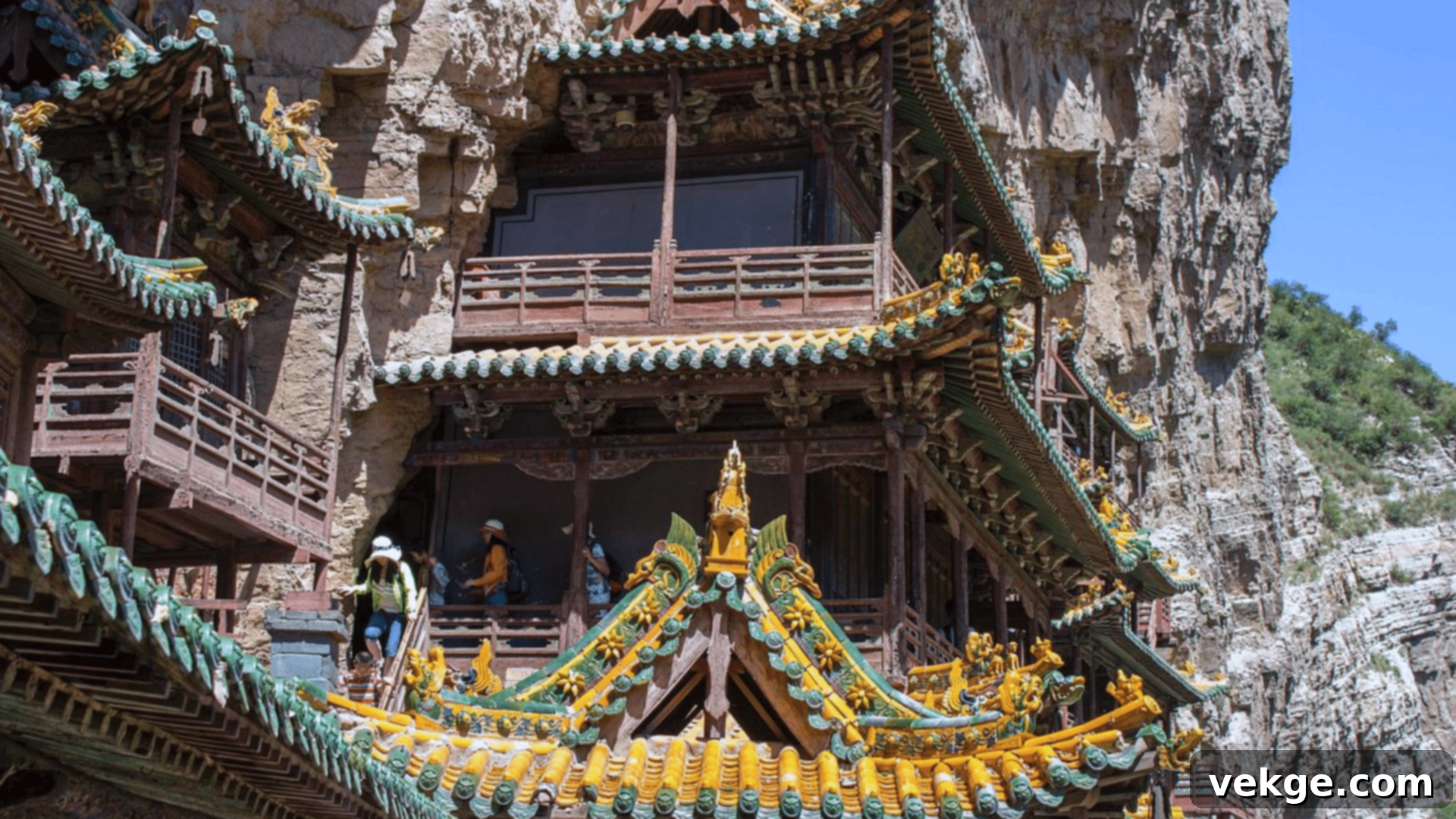
Perched precariously on a cliff face of Mount Heng in Shanxi province, the Hanging Monastery of Xuan Kong Si is an architectural marvel that has defied gravity for over 1,500 years. Built into the side of a sheer mountain, this extraordinary monastery appears to cling to the rock, supported by a system of wooden stilts and beams that seem impossibly delicate yet remarkably robust. Its unique construction allows it to withstand strong winds and torrential rains, a true testament to ancient Chinese engineering.
What makes this site even more remarkable is its religious synthesis; it is the only existing temple that seamlessly combines elements of Taoism, Buddhism, and Confucianism, housing statues and shrines for all three belief systems. Visitors navigate between its various halls and pavilions via narrow wooden walkways and steep staircases, experiencing a thrilling blend of spiritual reverence and awe-inspiring architectural daring. The Hanging Monastery stands as a poignant symbol of humanity’s ability to blend seamlessly with nature while achieving extraordinary feats of construction.
5. Temple of Confucius

The Temple of Confucius, located in Qufu, Shandong province, is the most revered and largest temple dedicated to the great philosopher Confucius. Originally built shortly after his death in 479 BC, it has undergone continuous expansion and renovation for over 2,000 years, growing into an expansive complex of grand halls, serene courtyards, and ancient cypress trees. The architectural style reflects traditional imperial designs, characterized by majestic red walls, vibrant golden-tiled roofs, and elegant white marble balustrades, creating a solemn and respectful atmosphere.
Within its sacred grounds, visitors can explore various halls, including the Dacheng Hall (Hall of Great Achievement), which serves as the main hall for ceremonies honoring Confucius. The temple also houses a vast collection of ancient steles and tablets, which are invaluable historical records, and a library preserving classical texts. As a UNESCO World Heritage site, the Temple of Confucius is not merely a building but a living embodiment of Confucian philosophy and a profound repository of Chinese history and cultural values.
6. Ningbo History Museum
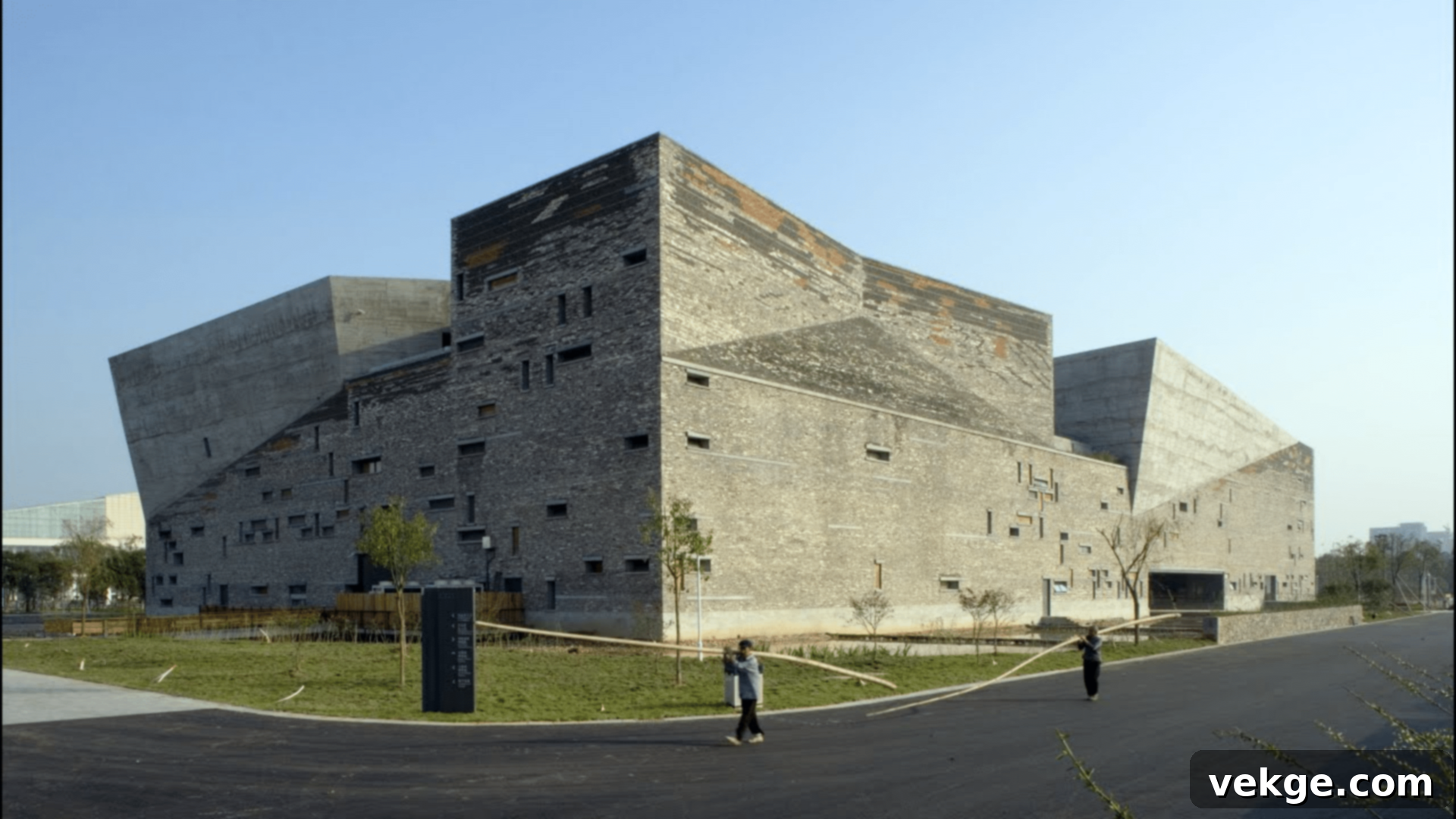
The Ningbo History Museum, designed by the Pritzker Prize-winning architect Wang Shu, is a striking example of modern Chinese architecture that respectfully integrates traditional materials and concepts. Located in Ningbo, Zhejiang province, the building’s exterior is a captivating mosaic of reclaimed bricks, tiles, and stones sourced from demolished traditional buildings. This unique approach gives the museum a textured, layered appearance, reminiscent of an ancient mountain range or stratified rock formations.
Wang Shu’s design philosophy emphasizes the harmonious blend of modern aesthetics with local craftsmanship and sustainable practices. The museum’s unusual, dynamic shapes and patterns, along with its sloping roofs and fragmented facades, create a dialogue between the past and present. Inside, the museum thoughtfully showcases the rich history and vibrant culture of Ningbo through its extensive collections. This innovative structure is not only a significant cultural institution but also an architectural landmark that champions environmental consciousness and the preservation of local heritage in a contemporary context.
7. Summer Palace

The Summer Palace, a sprawling imperial garden in Beijing, is a breathtaking masterpiece of classical Chinese landscape design. Originally constructed in 1750, this UNESCO World Heritage site is a perfect fusion of natural beauty and meticulously crafted artificial structures. At its heart lies the expansive Kunming Lake, alongside Longevity Hill, forming a picturesque backdrop for a myriad of traditional Chinese gardens, elaborate pavilions, and majestic temples.
Among its most celebrated features is the Long Gallery, a magnificent 728-meter-long covered walkway adorned with over 14,000 intricate paintings depicting scenes from Chinese classical literature, folklore, and landscapes. Another iconic structure is the Marble Boat, a beautifully crafted stone vessel serving as a permanent pavilion on the lake. Visitors can immerse themselves in the tranquil atmosphere, enjoy boat rides on the lake, and explore the exquisitely preserved imperial residences, experiencing the grandeur and artistic sophistication of Qing Dynasty imperial life. The Summer Palace truly embodies the pinnacle of traditional Chinese garden art.
8. Great Hall of the People

Dominating the western side of Tiananmen Square in Beijing, the Great Hall of the People is an imposing and symbolically significant building, serving as the legislative and ceremonial heart of the People’s Republic of China. Constructed in just ten months in 1959, this massive structure stands as a testament to the rapid development of modern China. Its grand neoclassical facade, adorned with a large national emblem above the main entrance, exudes an aura of immense state power and national pride.
The Great Hall plays a pivotal role in Chinese politics, hosting the annual sessions of the National People’s Congress and the Chinese People’s Political Consultative Conference, as well as various state banquets and important official events. Inside, it boasts an impressive array of conference rooms, offices, and a magnificent auditorium capable of seating thousands. Each province and region of China has its own dedicated hall within the building, reflecting regional diversity. The Great Hall of the People is a powerful symbol of China’s political authority and its distinctive modern architectural style.
9. National Grand Theater of China
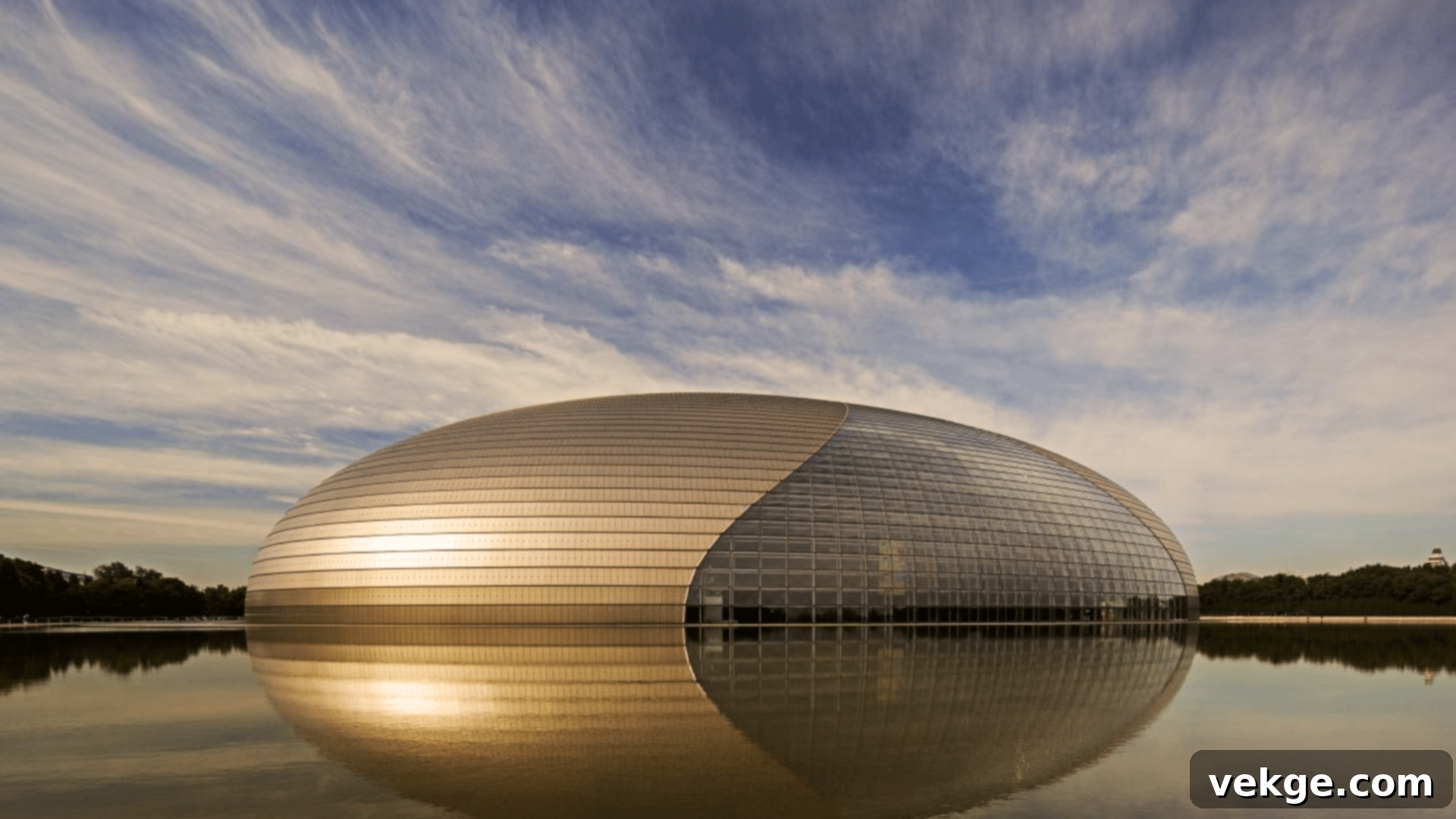
Adjacent to the Forbidden City in Beijing, the National Grand Theater of China, affectionately known as the “Egg,” is a breathtaking example of contemporary architectural artistry. Designed by French architect Paul Andreu, its unique, elliptical titanium and glass shell appears to float serenely on a large artificial lake, creating stunning reflections that change with the light of day. This futuristic design is a stark yet harmonious contrast to the ancient imperial structures nearby, symbolizing Beijing’s embrace of both its rich heritage and its modern aspirations.
Beneath its shimmering exterior, the complex houses three world-class performance venues: an opera house, a concert hall, and a theater, each meticulously designed for acoustic perfection. Visitors enter the building via a submerged glass corridor that passes under the reflecting pool, offering a dramatic sense of arrival. The National Grand Theater has quickly become a cultural beacon for Beijing, hosting international and domestic performances and solidifying its reputation as a hub for arts and culture, all encased in a truly iconic architectural form.
10. China Central Television Headquarters

The China Central Television (CCTV) Headquarters in Beijing is an internationally recognized architectural marvel, celebrated for its daring and unconventional design. Conceived by Rem Koolhaas and Ole Scheeren of OMA, the building challenges traditional skyscraper forms, creating a “Z-shaped” loop that appears as two leaning towers connected by a massive, cantilevered bridge. This dramatic structure, standing at 234 meters, is a prominent feature of Beijing’s modern skyline and has earned the nickname “Big Shorts” among locals.
Far from being just an aesthetic statement, the design ingeniously integrates the entire broadcasting process—administration, news, broadcasting, and program production—into a single, interconnected loop. This innovative approach to vertical and horizontal circulation fosters greater collaboration and efficiency. The CCTV Headquarters is not only one of China’s tallest buildings but also a powerful symbol of its growing influence in global media and technology, pushing the boundaries of architectural possibility and challenging perceptions of what a skyscraper can be.
11. Beijing National Stadium
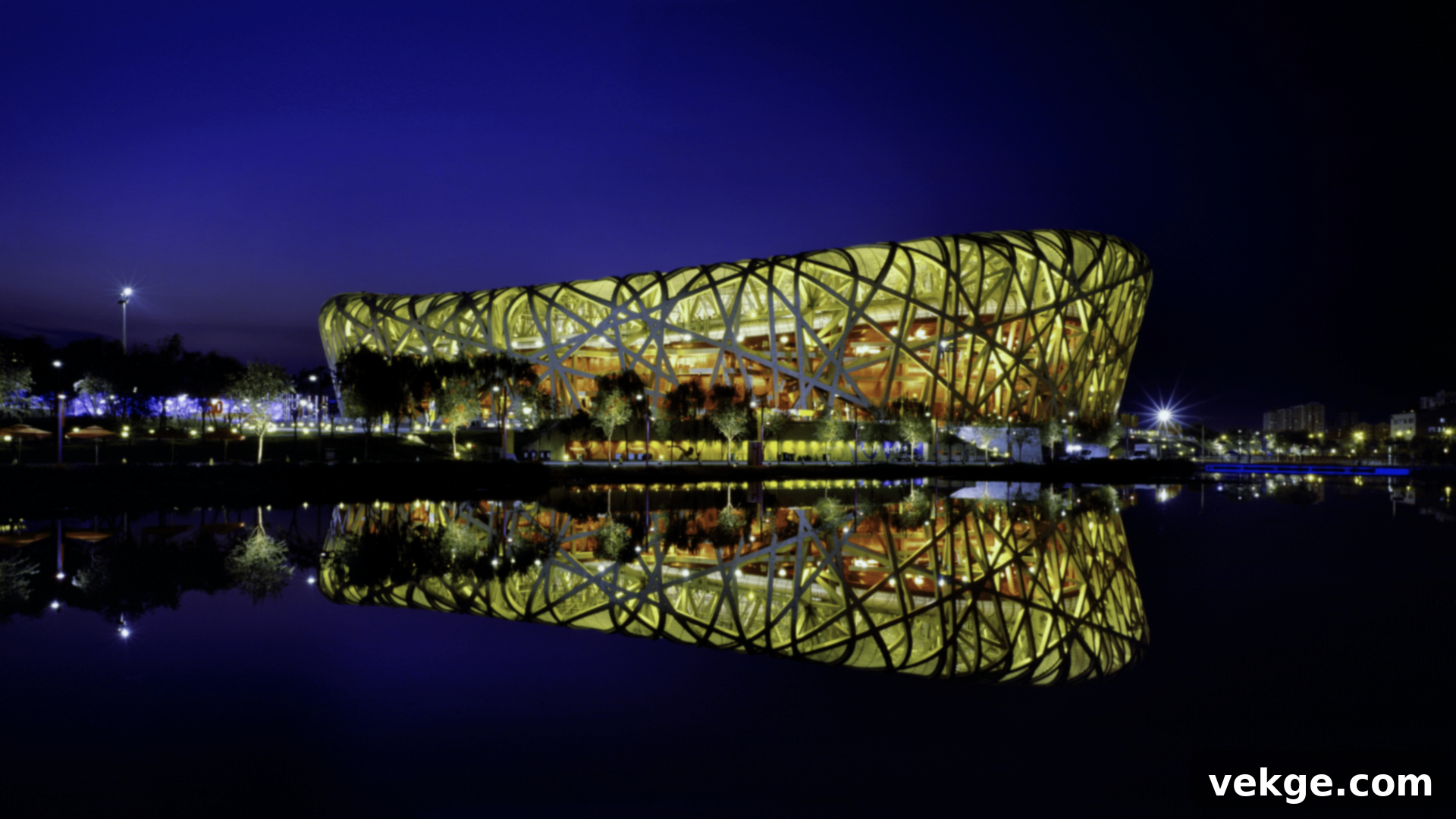
Famously known as the “Bird’s Nest,” the Beijing National Stadium is an architectural icon that captured global attention during the 2008 Summer Olympics. Designed by Swiss architects Herzog & de Meuron in collaboration with Chinese artist Ai Weiwei, its distinctive exterior is formed by an intricate web of crisscrossing steel beams, evoking the organic, interwoven structure of a bird’s nest. This visually striking design is not merely decorative; it provides both structural support and a unique aesthetic.
With a capacity to host 91,000 spectators, the stadium has been a venue for major sports events, grand ceremonies, and large-scale concerts, continuing to be a vibrant center for public life. The design cleverly integrates elements that are both robust and aesthetically pleasing, allowing for natural ventilation and a sense of openness. Surrounded by a thoughtfully designed park, the “Bird’s Nest” remains a key feature of Beijing’s urban landscape, a testament to innovative engineering and a lasting legacy of the Olympic Games.
12. Big Wild Goose Pagoda
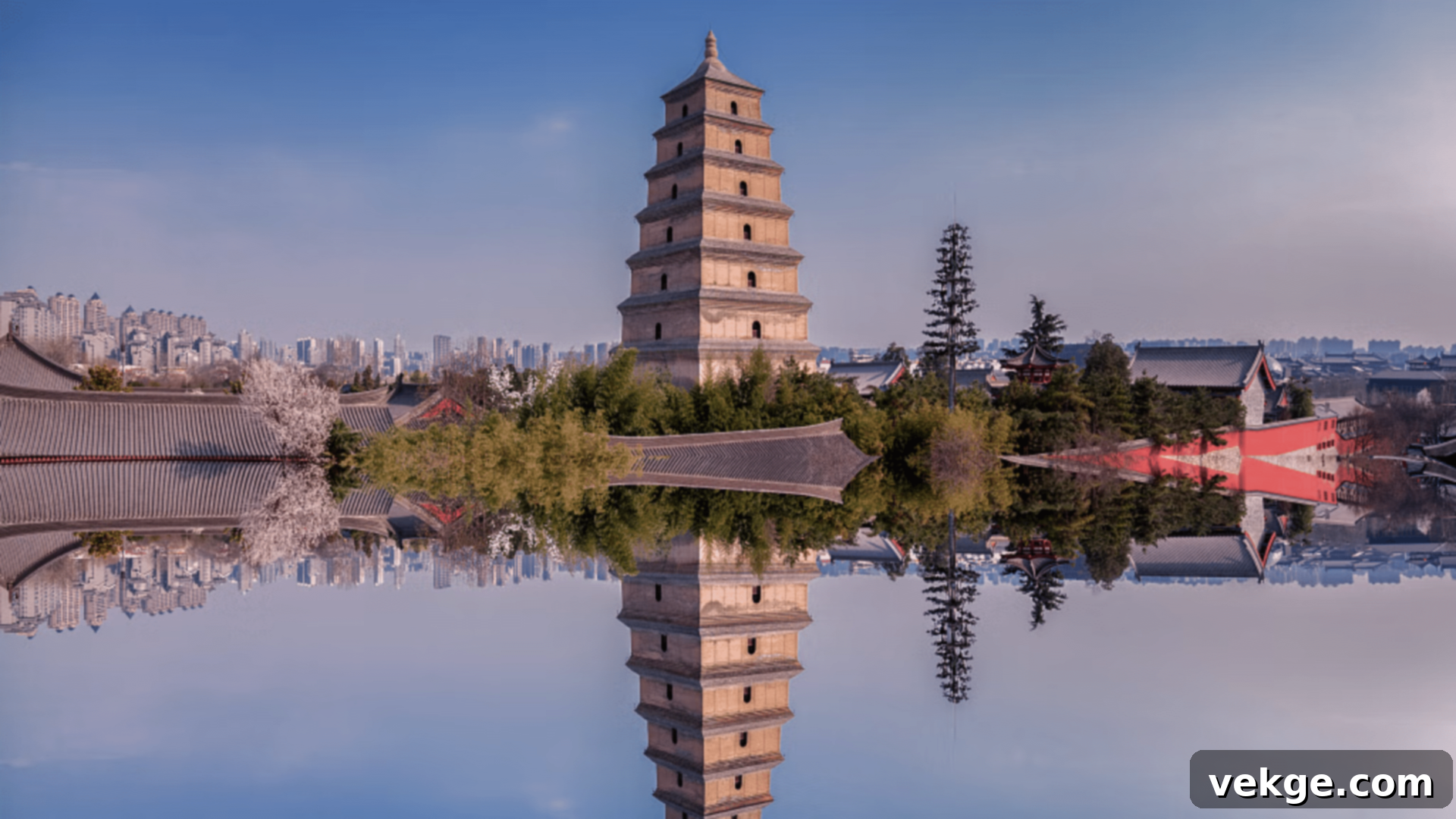
The Big Wild Goose Pagoda, rising majestically in Xi’an, Shaanxi province, is a significant Buddhist structure and an enduring symbol of the city’s rich imperial past. Originally constructed in 652 AD during the Tang Dynasty, the pagoda was built to house Buddhist scriptures and relics brought back from India by the revered monk Xuanzang. Its elegant, seven-story brick structure stands at a height of 64 meters, showcasing the distinctive architectural style of the Tang Dynasty.
Over the centuries, the pagoda has experienced several renovations, yet it retains its ancient charm. Interestingly, it has developed a slight lean over its long history, adding to its unique character. As one of China’s oldest and most renowned pagodas, it continues to attract countless visitors and pilgrims interested in Chinese history, Buddhist culture, and classical architecture. The surrounding Daci’en Temple complex, with its serene gardens and historical exhibits, further enriches the experience of this iconic Xi’an landmark.
13. Guangzhou Opera House
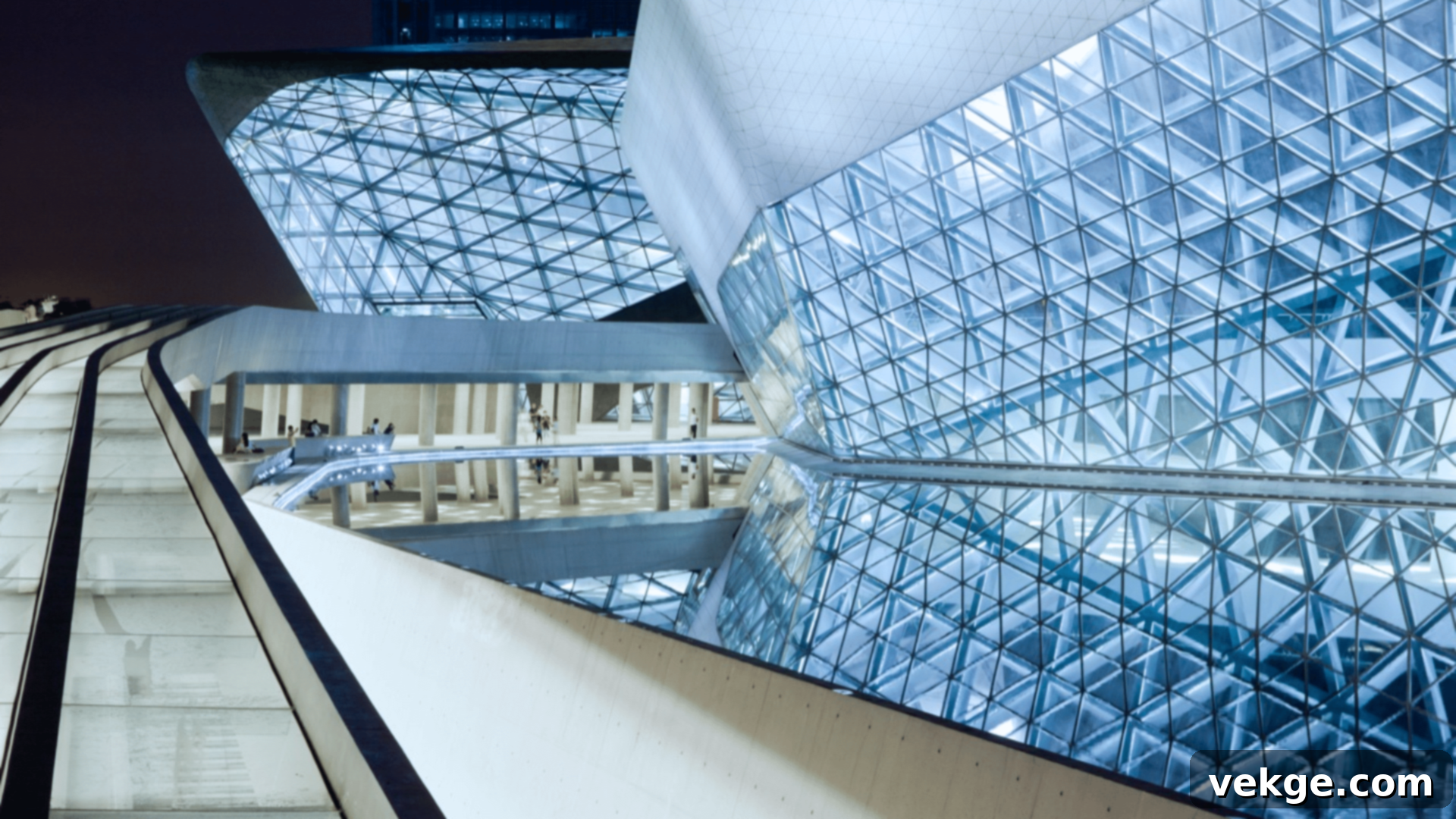
The Guangzhou Opera House is a breathtaking masterpiece of modern architecture, designed by the visionary Zaha Hadid. Located in the bustling city of Guangzhou, Guangdong province, its distinctive form evokes the image of two colossal river stones, smoothly sculpted by the flow of water. This organic design philosophy, inspired by the natural landscape and the Pearl River, gives the building a dynamic, fluid appearance that dramatically redefines its urban setting.
The opera house features two main performance halls: the Grand Theater and the Multi-Functional Theater, both renowned for their exceptional acoustics and state-of-the-art facilities. The exterior is clad in granite and glass, creating a multifaceted surface that captures and reflects light, giving it a different character depending on the time of day. The Guangzhou Opera House is not just a venue for performing arts but an architectural landmark that symbolizes Guangzhou’s growing cultural importance and its embrace of bold, innovative design on a global scale. It stands as a testament to Hadid’s unique parametric design approach and her ability to create fluid, sculptural forms.
14. Hong Kong and Shanghai Bank Headquarters

The Hong Kong and Shanghai Bank Headquarters, commonly known as the HSBC Building, is an instantly recognizable and highly influential landmark dominating Hong Kong’s impressive skyline. Designed by the acclaimed architect Sir Norman Foster and completed in 1985, this building was groundbreaking for its innovative structural and architectural approach. Instead of a traditional central core, its services and primary supports are located on the exterior, creating vast, flexible interior spaces.
A striking feature is its large, open glass atrium, which allows natural light to penetrate deep into the building, creating a bright and airy environment. The design prioritizes modularity and transparency, allowing for future adaptations. At the time of its construction, it was one of the most expensive buildings ever built, embodying Hong Kong’s rapid economic growth and development during the 1980s. The HSBC Building remains an iconic symbol of modern banking architecture and a testament to pioneering engineering, seamlessly blending functionality with a distinctive aesthetic.
15. Bank of China Tower
Soaring dramatically above Hong Kong’s financial district, the Bank of China Tower is an undeniable architectural icon, renowned for its striking and distinctive design. Conceived by the celebrated architect I.M. Pei, the tower’s unique form is characterized by four triangular glass and steel towers that appear to interlock and rise from the ground, resembling bamboo shoots, a traditional Chinese symbol of growth and vitality. When completed in 1990, it proudly stood as the tallest building in Hong Kong and the first skyscraper outside the United States to surpass 1,000 feet.
The tower’s asymmetrical structure and sharp, geometric lines make it instantly recognizable in the city’s dense skyline. Pei’s design masterfully blends modern architectural principles with subtle references to traditional Chinese symbolism, creating a building that is both futuristic and culturally resonant. Its innovative structural system, which utilizes a space frame to resist wind loads, was also a significant engineering achievement. The Bank of China Tower continues to be a powerful emblem of Hong Kong’s global financial status and an outstanding example of modern architectural ingenuity.
16. Custom House
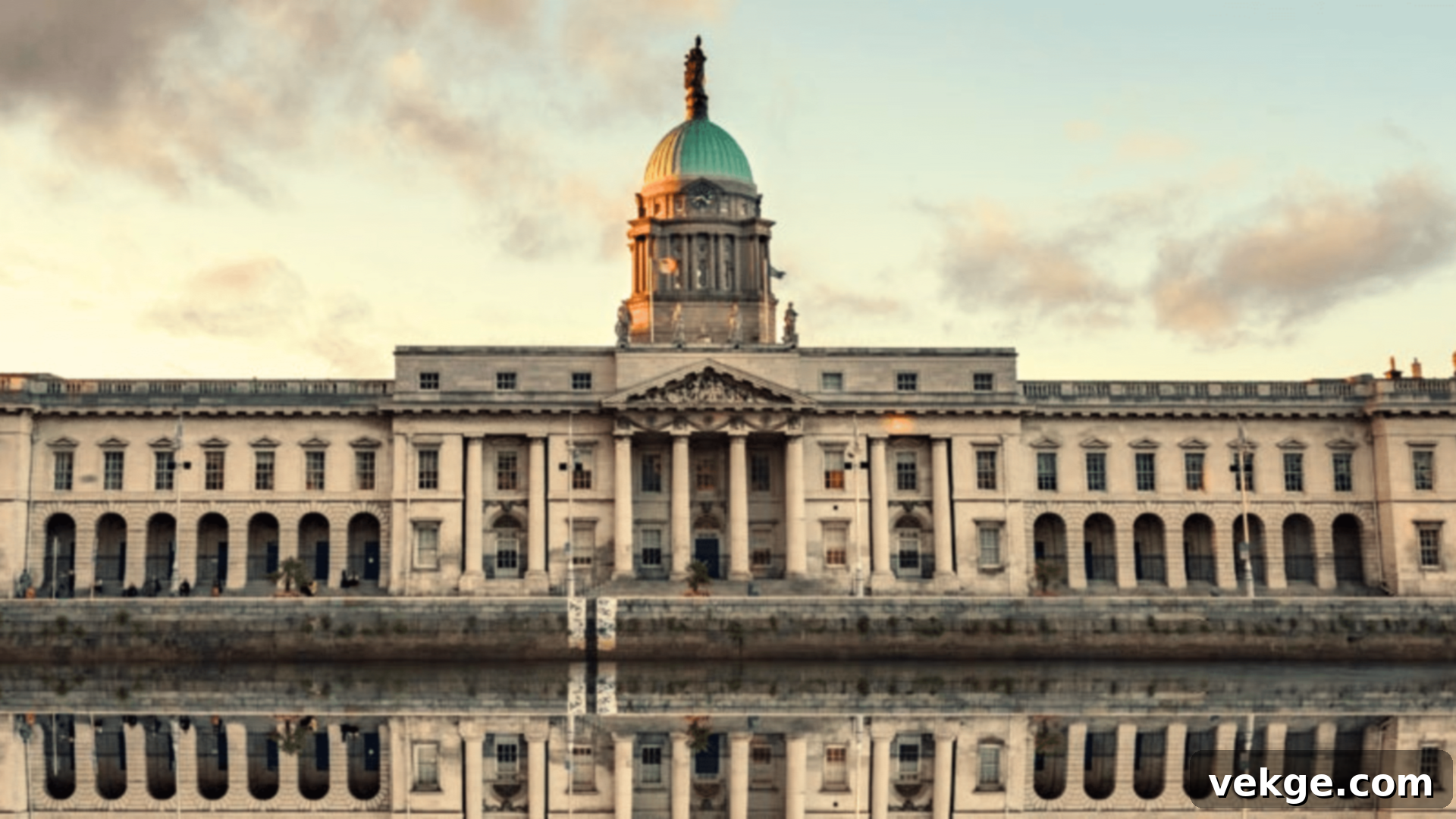
The Custom House stands as a magnificent historical landmark on the famous Bund waterfront in Shanghai, epitomizing the city’s rich colonial past. Designed by the British firm Palmer & Turner and completed in 1927, this grand edifice is a quintessential example of Neoclassical architecture. Its imposing facade features majestic Doric columns, intricate stone carvings, and a sense of enduring solidity that speaks to the power and prestige of the customs authority it once housed.
A distinctive feature of the Custom House is its prominent clock tower, which houses a replica of Big Ben’s clock and chimes. This iconic timepiece has marked the hours for Shanghai residents for nearly a century, becoming an integral part of the city’s soundscape. Overlooking the bustling Huangpu River, the Custom House remains a pivotal structure on the Bund, serving as a powerful visual reminder of Shanghai’s pivotal role as an international port city and a testament to the architectural styles that shaped its historic waterfront.
17. Park Hotel
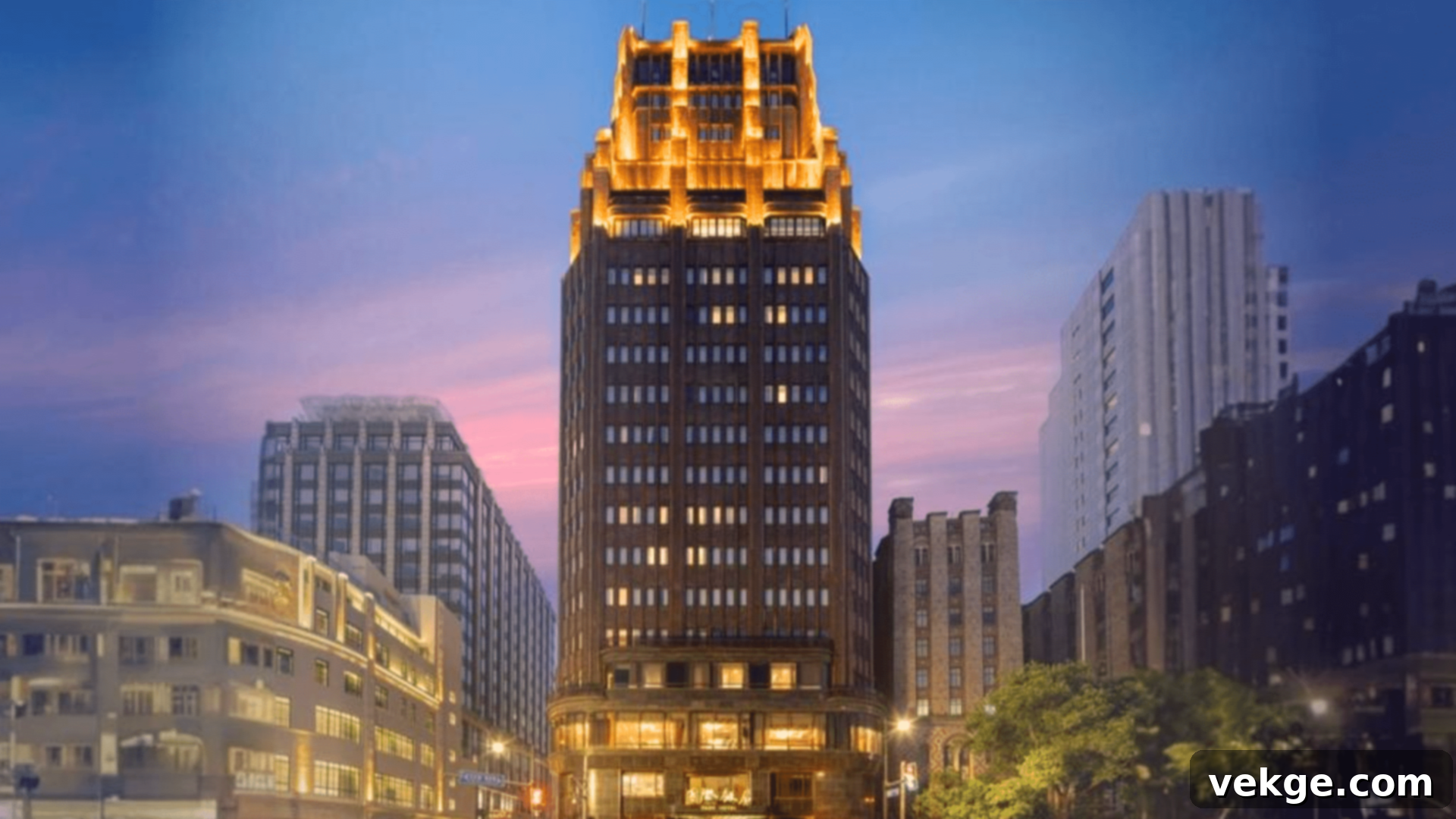
The Park Hotel in Shanghai holds a significant place in the city’s architectural history as a pioneering skyscraper. Designed by the Hungarian-Slovak architect László Hudec and completed in 1934, it proudly stood as the tallest building in Asia and a symbol of Shanghai’s modernity for decades. Rising 22 stories, its distinctive Art Deco design features a tapered shape and clean, vertical lines that were revolutionary for its time, dramatically altering Shanghai’s skyline.
Hudec’s design blended Western architectural trends with local contextual elements, creating a building that was both elegant and functional. The hotel quickly became a social hub for Shanghai’s elite and international visitors, known for its luxurious accommodations and panoramic city views. While new, taller skyscrapers have since redefined Shanghai’s horizon, the Park Hotel remains a cherished historic and architectural landmark, offering a tangible link to the city’s glamorous “Paris of the East” era and a testament to early modern architecture in China.
18. Jin Mao Tower
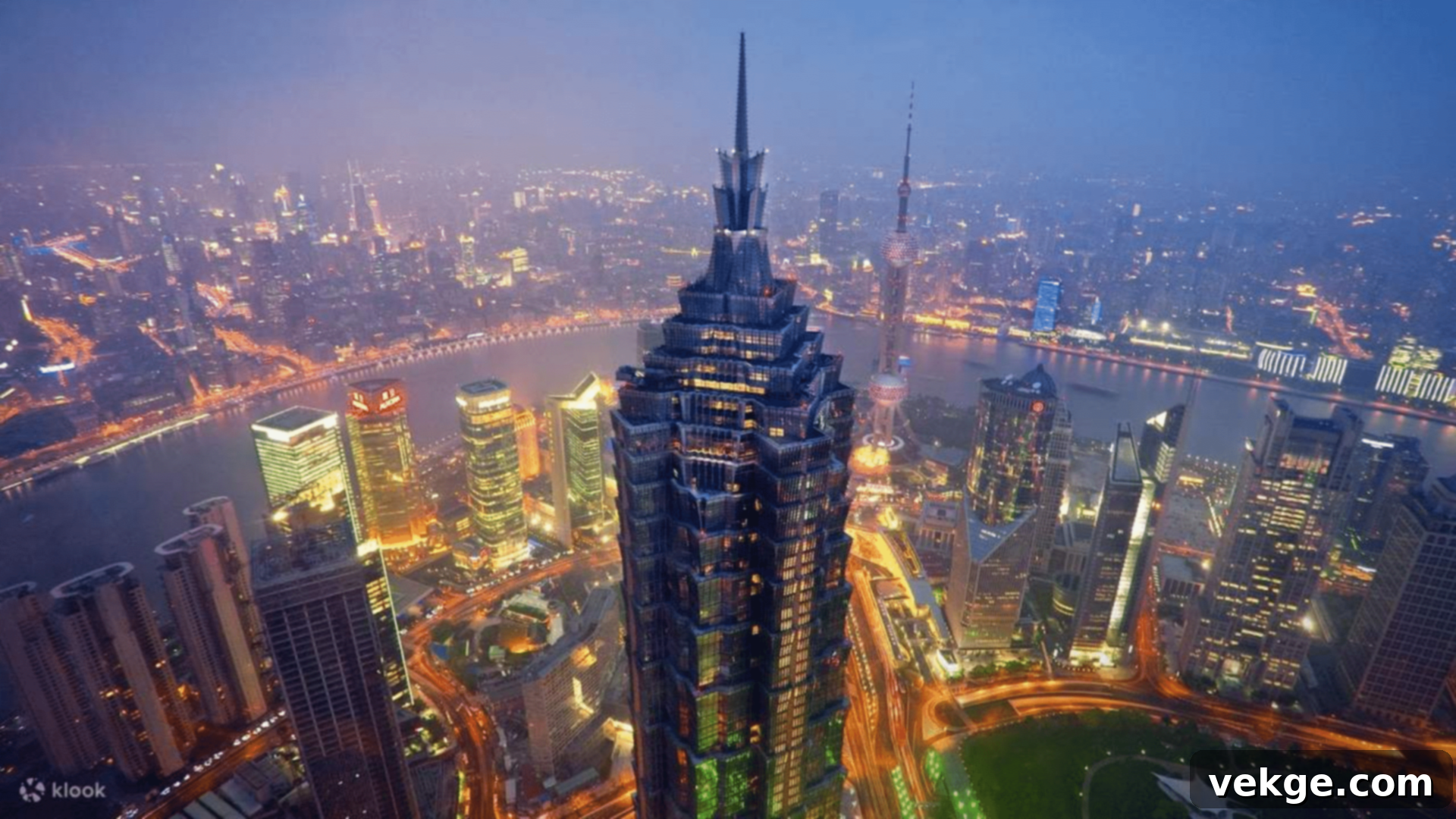
The Jin Mao Tower, an iconic supertall skyscraper in Shanghai’s Pudong district, was a monumental achievement in modern Chinese architecture when it was completed in 1999. Standing at 420.5 meters (1,380 feet) with 88 stories, it held the title of China’s tallest building for several years. Designed by the American firm Skidmore, Owings & Merrill (SOM), the tower’s elegant profile is deeply inspired by traditional Chinese pagoda architecture, featuring a unique stepped design that tapers gracefully towards the sky.
The exterior combines an advanced aluminum curtain wall with glass panels, reflecting the city and sky. Its number of floors, 88, is considered highly auspicious in Chinese culture, symbolizing prosperity and good fortune. Inside, the tower houses offices, retail spaces, and the Grand Hyatt Shanghai hotel, famous for its breathtaking atrium that extends almost the entire height of the building. Visitors to the observation deck on the 88th floor are treated to spectacular panoramic views of Shanghai, making the Jin Mao Tower a must-visit for its architectural grandeur and cultural resonance.
19. The Shanghai Oriental Arts Center
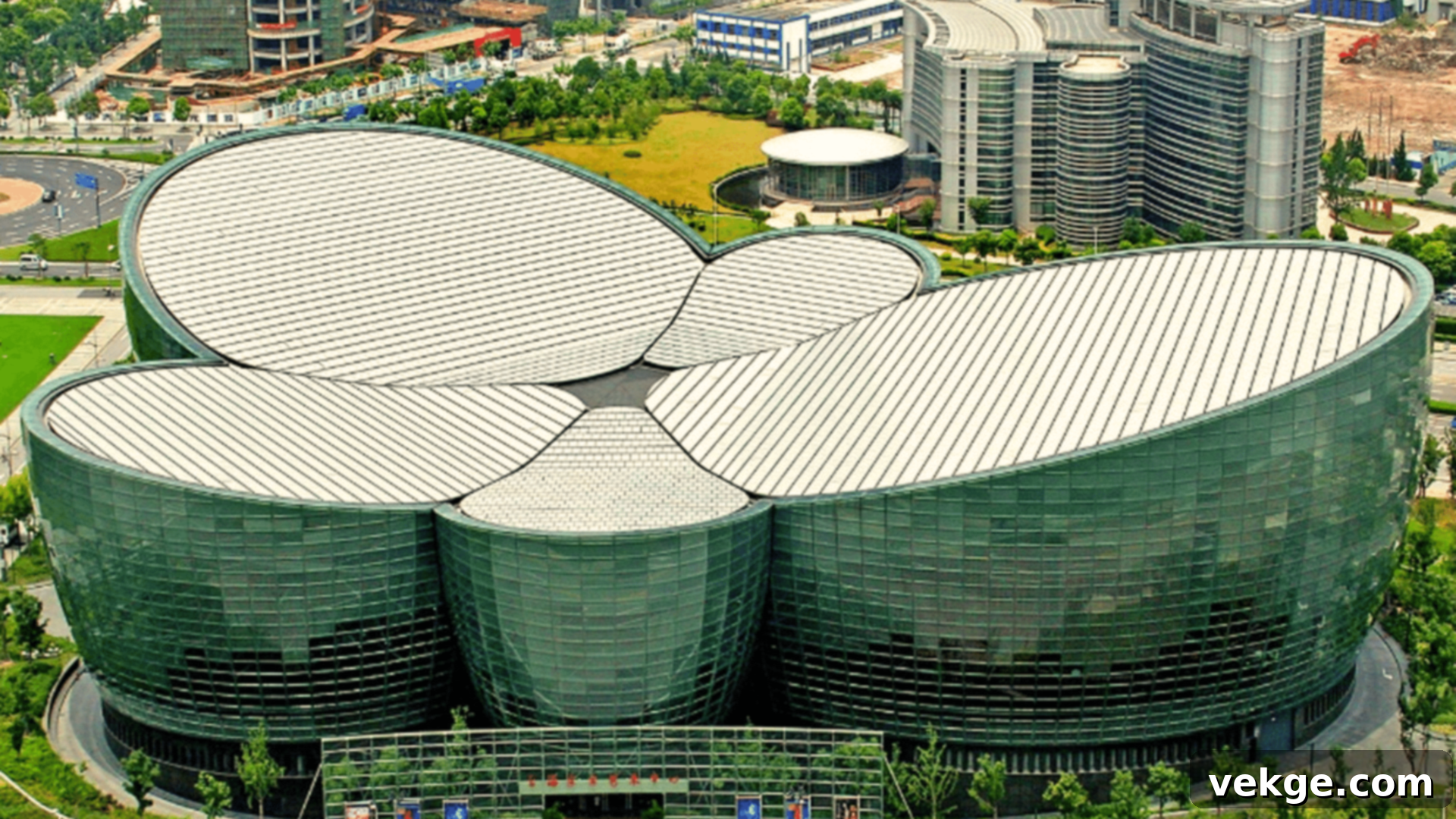
The Shanghai Oriental Arts Center, a stunning architectural gem located in the heart of Pudong, Shanghai, is renowned for its distinctive and organic design. Conceived by French architect Paul Andreu, the building’s form strikingly resembles a five-petal flower or perhaps five semi-transparent pebbles clustered together, with each “petal” housing a different functional area. Its curved, glass-clad sections rise gracefully from the ground, creating a sense of fluidity and lightness.
Inside, the center features three world-class performance halls: a concert hall, an opera house, and a performance exhibition hall, along with an exhibition gallery. The interior walls are beautifully finished with smooth porcelain tiles, reminiscent of river pebbles, further enhancing the natural theme. At night, the center is dramatically illuminated, transforming into a glowing lotus flower against the city skyline. The Shanghai Oriental Arts Center stands as a peaceful oasis amidst the urban dynamism, successfully blending natural inspiration with modern design to create a vibrant hub for culture and performing arts.
20. Shenzhen Airport Terminal
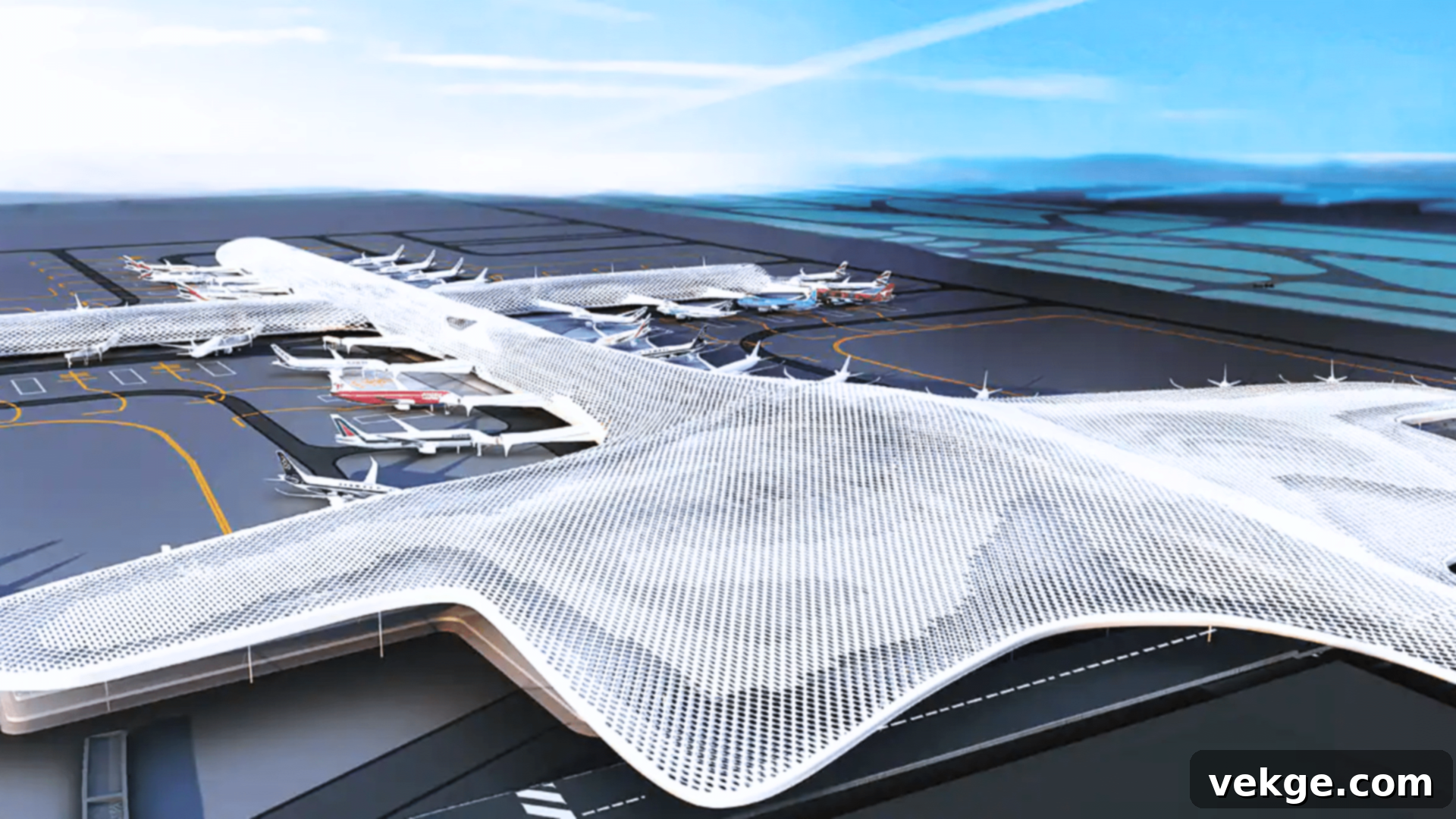
The Shenzhen Airport Terminal 3, designed by the Italian architectural firm Studio Fuksas, is a remarkable example of contemporary airport design, renowned for its immense scale and innovative aesthetic. Opened in 2013, the terminal’s unique form is inspired by the graceful shape of a manta ray, with a flowing, curvilinear structure that emphasizes seamless movement and natural light. Its pristine white exterior and distinctive conical supporting columns create a futuristic and highly functional space.
The terminal’s roof is punctuated by numerous hexagonal skylights, which are also reflected in the patterned metal cladding of the interior, creating a sense of light and spaciousness while guiding passengers intuitively. This design ensures that vast amounts of natural light flood the departure halls, minimizing the need for artificial lighting during the day. As one of China’s busiest cities, Shenzhen’s airport terminal not only handles millions of passengers efficiently but also stands as a significant architectural statement, showcasing cutting-edge design and engineering in a major transportation hub.
21. Hall of Prayer for Good Harvests

The Hall of Prayer for Good Harvests is the crowning jewel of the vast Temple of Heaven complex in Beijing, an imperial sacred site of unparalleled beauty and historical significance. This magnificent circular building, with its distinctive triple-eaved, deep-blue tiled roof, symbolizes the celestial realm and earth. It was here that emperors of the Ming and Qing dynasties would perform solemn ceremonies, praying for bountiful harvests, a ritual crucial for the well-being of the empire.
Remarkably, the entire hall is constructed without the use of a single nail, relying instead on intricate traditional Chinese joinery techniques. It stands majestically on a three-tiered marble terrace, reached by a grand staircase. Inside, the hall is adorned with resplendent golden decorations and a beautifully patterned marble floor, reflecting the imperial reverence for heaven. As a UNESCO World Heritage site, the Hall of Prayer for Good Harvests is not only an architectural marvel but also a powerful emblem of ancient Chinese spiritual beliefs, imperial power, and profound cultural heritage.
22. Hall of Supreme Harmony

Within the immense grandeur of the Forbidden City in Beijing, the Hall of Supreme Harmony stands as the largest and most important structure, representing the apex of imperial power. This imposing hall, situated on a three-tiered marble base, was the ceremonial heart of the palace, primarily used for significant state affairs, enthronement ceremonies, imperial weddings, and the reception of high-ranking officials. Its majestic double-eaved roof, adorned with gleaming yellow glazed tiles, symbolizes the emperor’s supreme authority.
The interior is a breathtaking display of imperial splendor, dominated by the elaborate Dragon Throne, intricately carved with 13 golden dragons and surrounded by various auspicious symbols. Every detail, from the vibrant colors to the detailed woodwork, is imbued with symbolic meaning, emphasizing the emperor’s divine right to rule. The Hall of Supreme Harmony is a paramount example of traditional Chinese palatial architecture, showcasing meticulous craftsmanship and a profound understanding of symbolic design. It remains a powerful testament to the opulence and might of China’s imperial dynasties.
23. Tiger Hill Pagoda
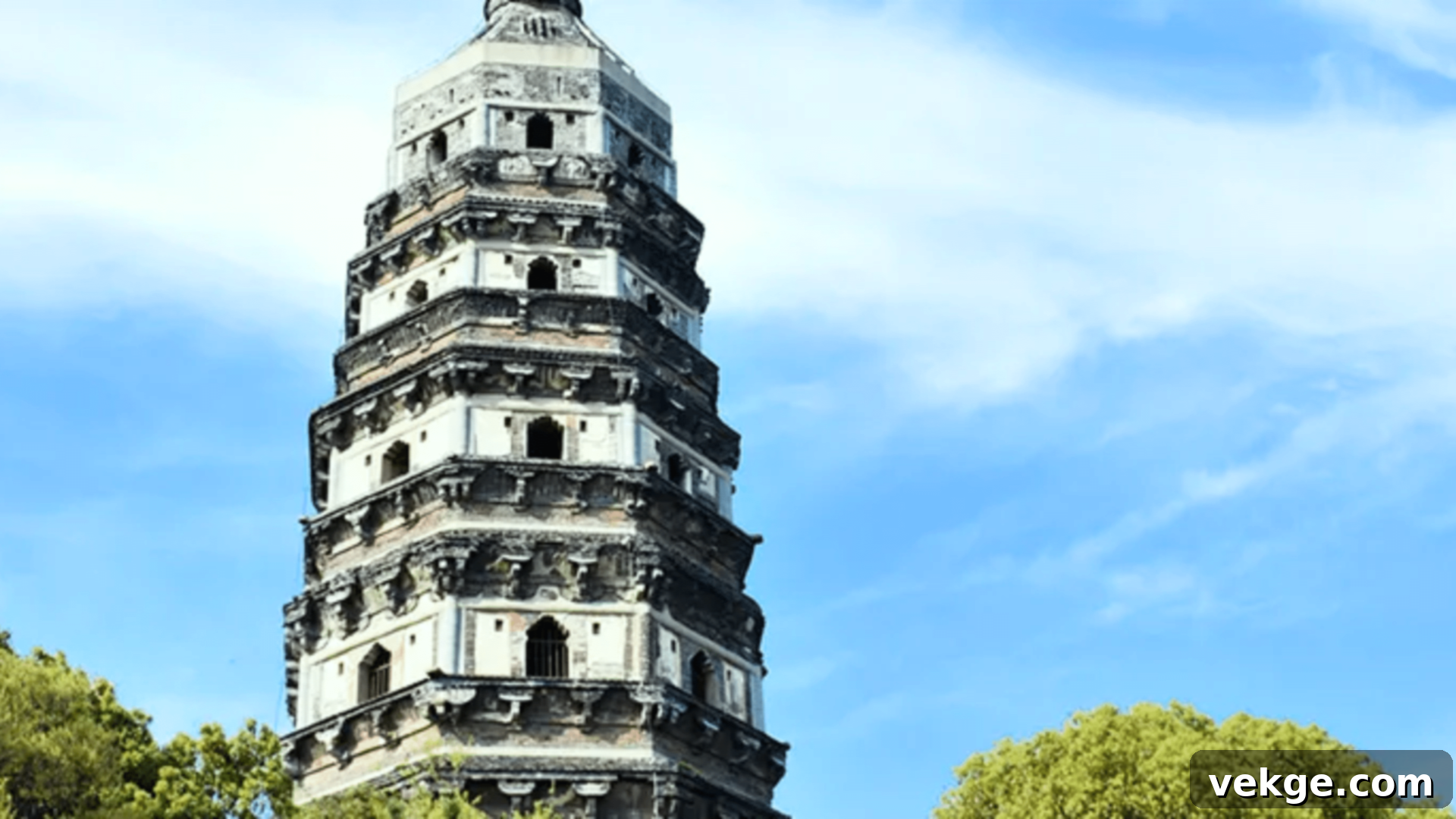
The Tiger Hill Pagoda, officially known as the Yunyan Pagoda, is a revered historical landmark nestled within the scenic Tiger Hill complex in Suzhou, Jiangsu province. Built during the Northern Song Dynasty (959-961 AD), this impressive seven-story brick pagoda stands tall at 47 meters. What makes it particularly famous and captivating is its noticeable lean, earning it the affectionate moniker “the Leaning Tower of China.” This tilt, caused by subsidence over centuries, has been a feature for over 400 years.
Constructed primarily from brick, the pagoda is elegantly decorated with intricate patterns and traditional architectural elements, showcasing the sophisticated building techniques of its era. Despite its lean, the structure remains remarkably stable and continues to attract countless visitors who are fascinated by its history and unique appearance. The Tiger Hill Pagoda is not only an important Buddhist relic but also a prominent symbol of Suzhou, an ancient city renowned for its classical gardens and rich cultural heritage.
24. Coffee House, Jinhua Architecture Park
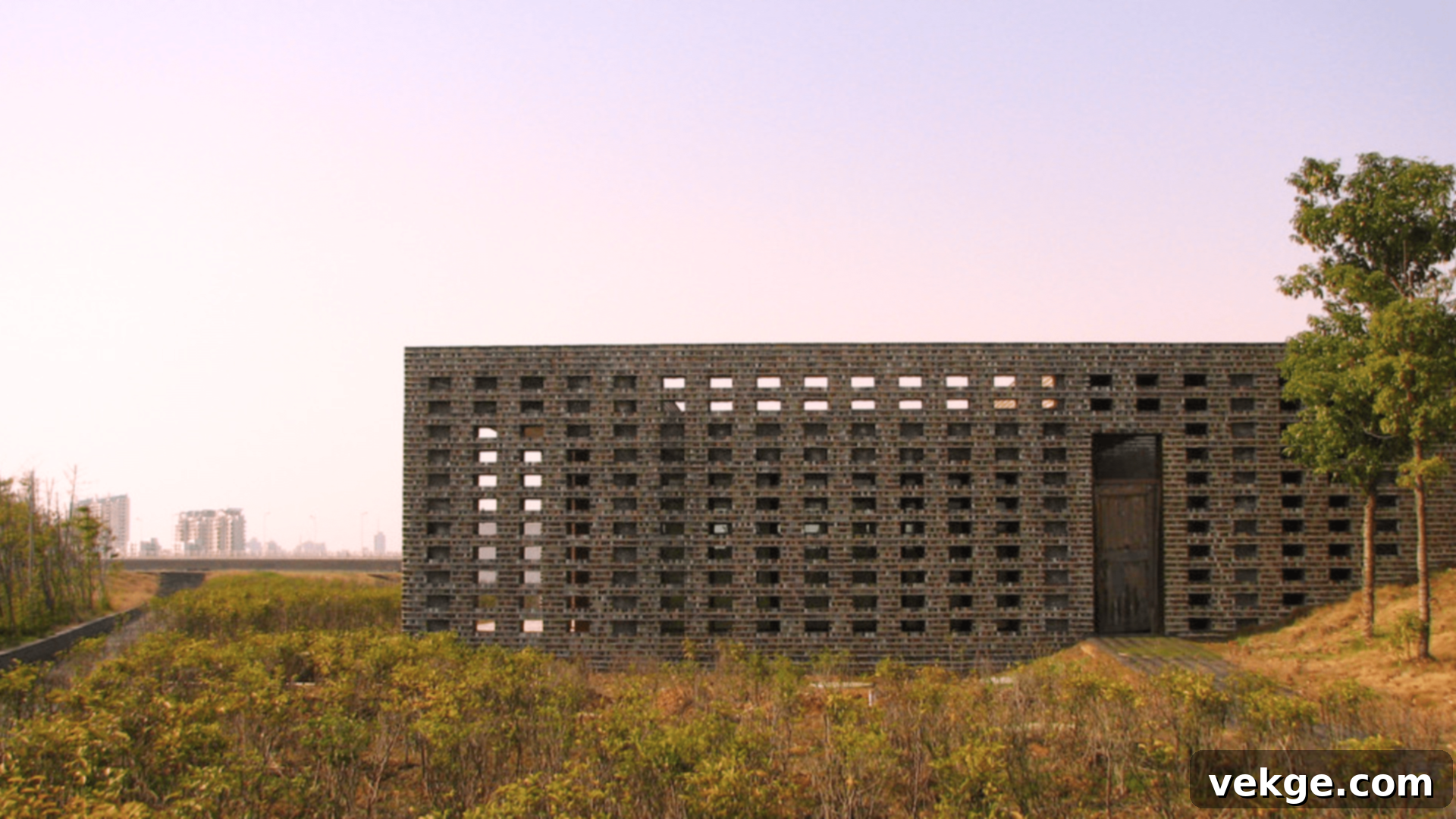
Within the innovative Jinhua Architecture Park in Jinhua, Zhejiang province, stands the distinctive Coffee House, a creation of the renowned Pritzker Prize-winning architect Wang Shu. This building challenges conventional design with its seemingly simple yet profoundly intricate aesthetic. Shaped like a minimalist cube, one side of the structure is characterized by a series of small, square perforations, allowing light and views to filter through in a unique pattern.
The entire exterior of the Coffee House is clad in a mesmerizing mosaic of tiny, multi-colored tiles, creating a rich, textured surface that shifts in appearance with varying light conditions. This detailed surface treatment contrasts beautifully with the building’s stark geometric form, showcasing Wang Shu’s mastery in blending simple shapes with complex, tactile finishes. As part of an architectural park featuring works by numerous international architects, the Coffee House stands out as a compelling example of how architecture can explore the interplay between form, texture, and light, offering a refreshing and thought-provoking experience.
25. Forbidden City
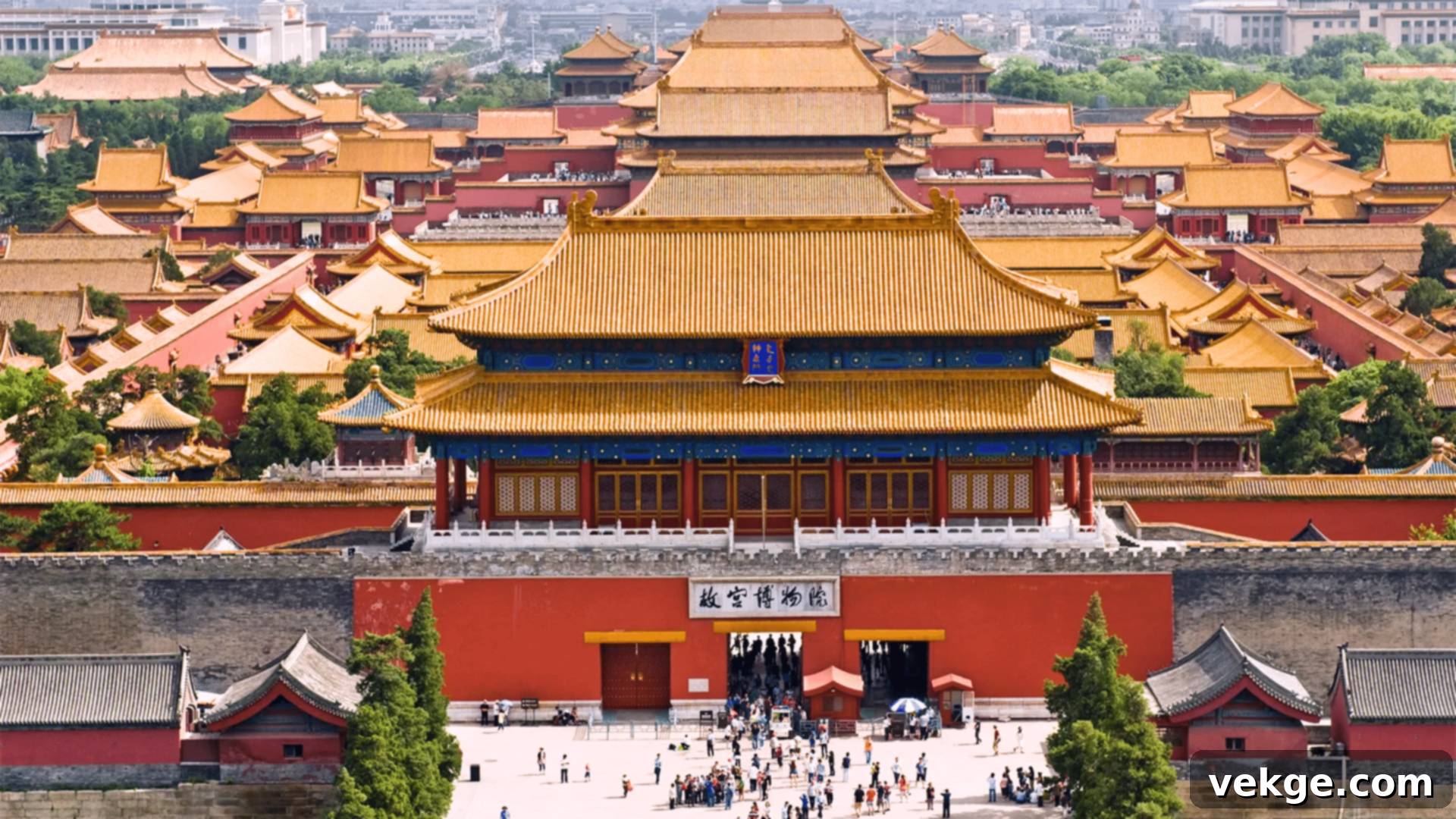
At the very heart of Beijing lies the Forbidden City, an awe-inspiring imperial palace complex that served as the home of Chinese emperors and their households for nearly 500 years, from the Ming Dynasty to the end of the Qing Dynasty. Constructed between 1406 and 1420, this immense complex comprises over 900 exquisitely preserved buildings, making it the largest ancient palatial structure in the world. It was aptly named “Forbidden” because access was strictly restricted; no one could enter or leave without imperial permission.
Enclosed by a formidable 7.9-meter-high wall and a 52-meter-wide moat, the Forbidden City is a meticulously organized miniature city, embodying traditional Chinese palatial architecture. Its layout reflects a cosmic order, with a clear central axis and buildings arranged according to principles of harmony and balance. Today, it functions as the Palace Museum, welcoming millions of visitors annually to explore its grand halls, intricate courtyards, and vast collections of imperial artifacts. A UNESCO World Heritage site, the Forbidden City remains an unparalleled symbol of China’s imperial past, its rich culture, and its enduring architectural legacy.
26. The Temple of Heaven
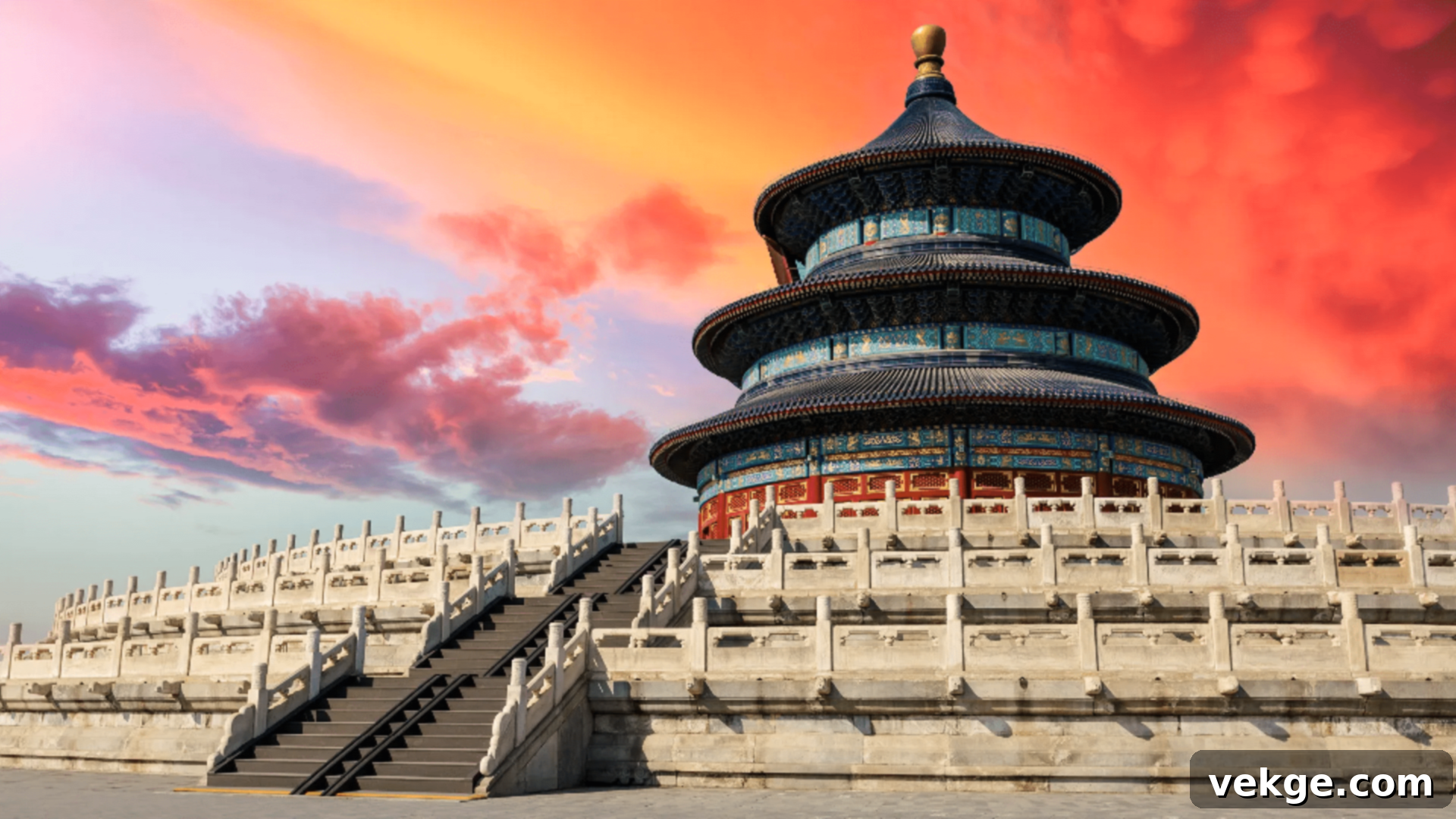
The Temple of Heaven, located in southeastern Beijing, is a magnificent complex of imperial religious buildings deeply imbued with symbolic significance. Constructed during the Ming Dynasty in the early 15th century, it served as a sacred site where emperors, as the “Son of Heaven,” would perform elaborate rituals to pray for good harvests, favorable weather, and national prosperity. The architectural design of the temple perfectly embodies ancient Chinese cosmology, with round buildings and altars symbolizing heaven, and square grounds representing the earth.
The complex is set within a vast, tranquil park, which provides a serene escape from the urban bustle. Key structures include the Hall of Prayer for Good Harvests, the Imperial Vault of Heaven, and the Circular Mound Altar, all meticulously designed with blue-tiled roofs to signify their connection to the sky. The alignment and proportions of the buildings are based on cosmic principles, creating a profound sense of harmony and reverence. As a UNESCO World Heritage site, the Temple of Heaven is an invaluable testament to Chinese spiritual beliefs, architectural ingenuity, and imperial rituals, offering visitors a peaceful yet profound cultural experience.
27. Tiananmen Square
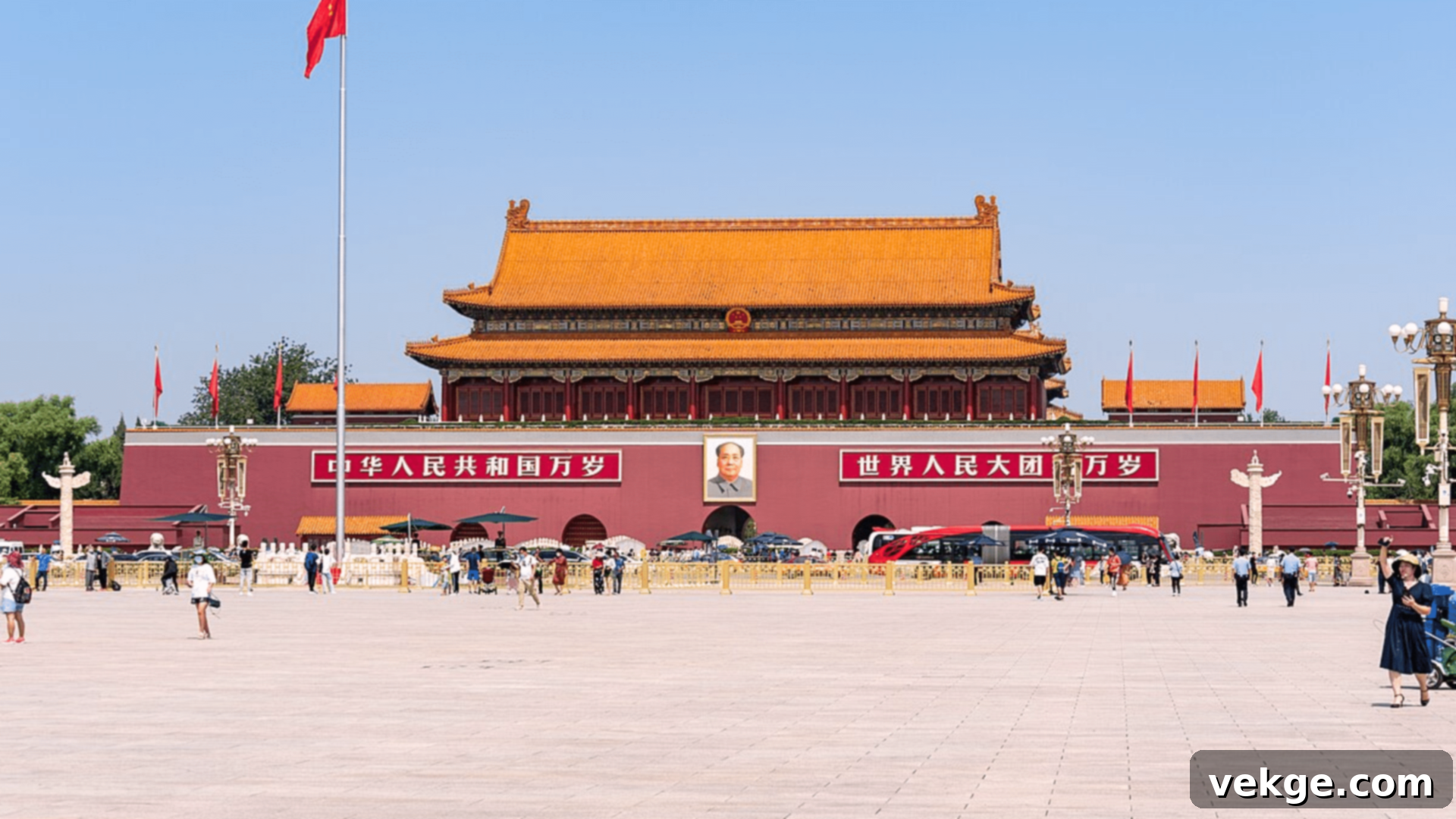
Tiananmen Square, situated at the very heart of Beijing, is one of the largest and most historically significant public squares in the world. Encompassing an expansive area, it serves as a central gathering place for national celebrations, ceremonies, and political events, embodying the spirit and history of modern China. The square is bordered by several iconic buildings that contribute to its monumental scale and importance.
To its west stands the majestic Great Hall of the People, the legislative center, while to the east is the National Museum of China, housing vast collections of Chinese art and history. The square is also home to the towering Monument to the People’s Heroes and the solemn Mausoleum of Mao Zedong. At its northern end, the famous Tiananmen Gate, with its portrait of Chairman Mao, marks the entrance to the Forbidden City. Tiananmen Square is a popular destination for both locals and international tourists, offering a profound sense of scale, history, and national identity, and serves as a crucial point of reference for understanding China’s past and present.
28. The Bund
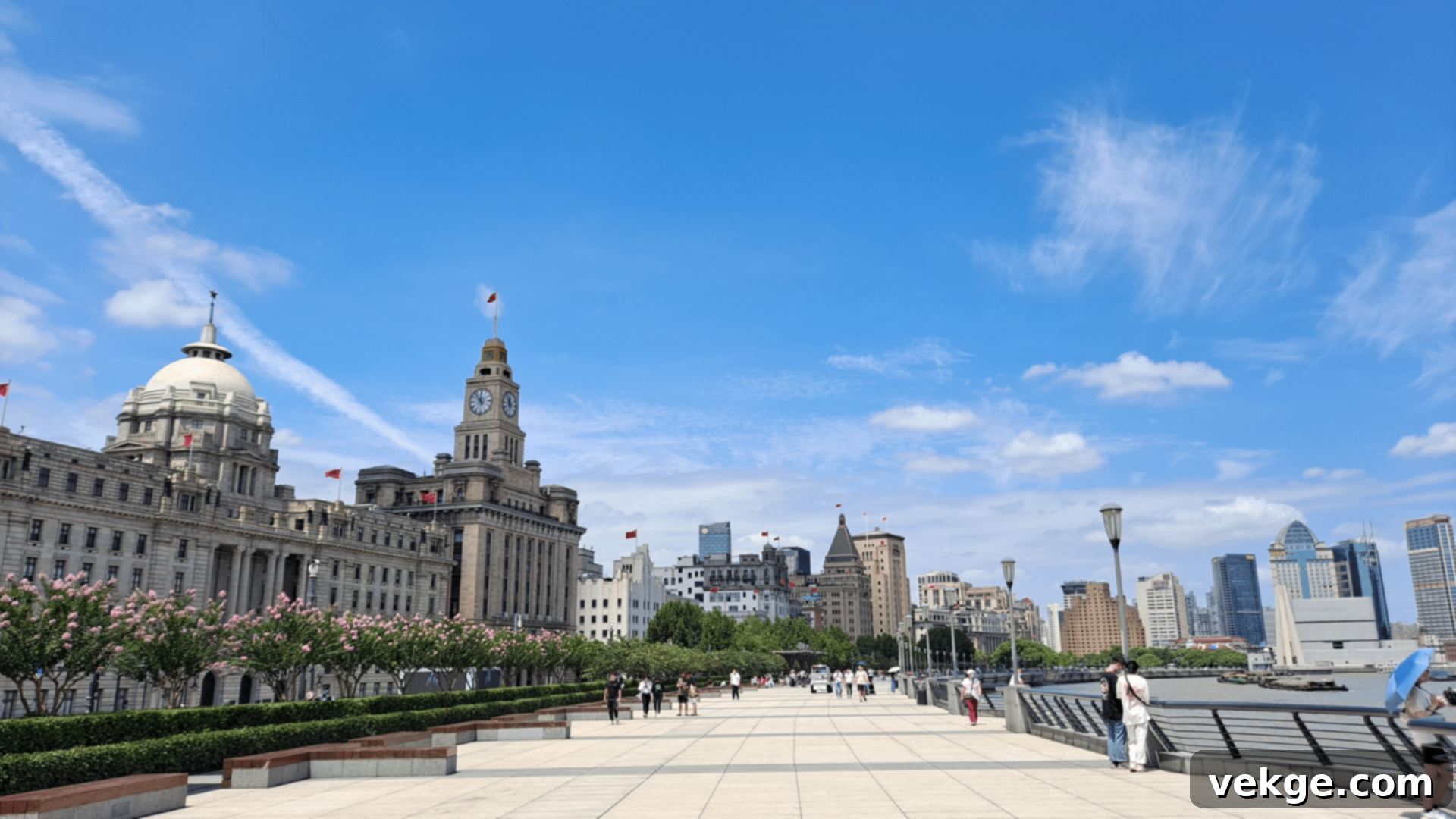
The Bund, a celebrated waterfront promenade along the Huangpu River in Shanghai, is perhaps the city’s most iconic and evocative landmark. This historic strip is renowned for its impressive collection of colonial-era buildings, showcasing a fascinating blend of architectural styles, including Gothic, Romanesque, Baroque, Neoclassical, and Art Deco. These grand edifices, built in the late 19th and early 20th centuries by foreign banks and trading houses, speak volumes about Shanghai’s past as a vibrant international port and a global financial hub.
Walking along the Bund offers a captivating journey through time, allowing visitors to appreciate the city’s rich heritage on one side, while across the river, the futuristic skyline of Pudong, with its glittering skyscrapers like the Oriental Pearl Tower and Shanghai Tower, represents modern China’s dazzling progress. The Bund is a quintessential spot for sightseeing, capturing stunning photographs, and simply enjoying the dynamic interplay between old and new Shanghai. It remains an absolute must-see destination for anyone visiting this remarkable city, providing an unforgettable visual spectacle day and night.
Conclusion: A Journey Through China’s Architectural Splendor
China’s architectural landscape is an extraordinary tapestry, woven with threads of deep history, profound culture, and visionary innovation. From the ancient, spiritual havens of the Shaolin Temple and the Hanging Monastery, where faith and engineering defied the impossible, to the imperial grandeur of the Forbidden City and the Temple of Heaven, reflecting centuries of dynastic power and cosmic beliefs, each structure tells a compelling story of human achievement and artistic expression.
The journey through these famous Chinese buildings also highlights the nation’s remarkable progression into modernity. Iconic structures like the Bird’s Nest, the Guangzhou Opera House, and the Shanghai Tower stand as bold testaments to contemporary design, pushing the boundaries of what is possible and symbolizing China’s influential role on the global stage. These landmarks are not merely physical constructions; they are living testaments to an evolving narrative, blending ancient traditions with cutting-edge aesthetics.
Whether you are drawn to the serenity of an ancient pagoda, the complexity of imperial palaces, or the sleek lines of a futuristic skyscraper, exploring these architectural wonders offers a deeper, more nuanced understanding of China’s past, present, and its boundless future. Each visit provides an opportunity to connect with different facets of Chinese heritage and appreciate the enduring spirit of innovation that has shaped this vast and vibrant country.
Make sure to incorporate these must-see architectural marvels into your itinerary on your next unforgettable trip to China. Prepare to be inspired by the sheer diversity and beauty that defines Chinese architecture, truly a feast for the eyes and a journey for the soul.
If you found this comprehensive guide helpful and inspiring, we encourage you to explore other engaging articles and travel resources available on our website for more insights and inspiration for your next adventure!
